外研版一起五年级上册知识点汇总
外研社五年级英语上册知识点总结
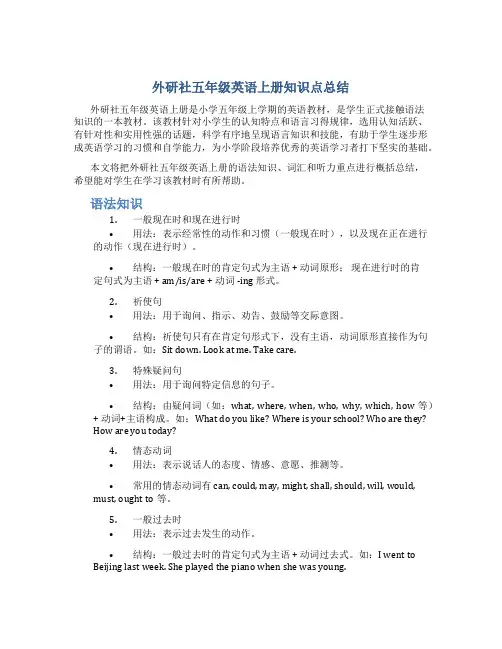
外研社五年级英语上册知识点总结外研社五年级英语上册是小学五年级上学期的英语教材,是学生正式接触语法知识的一本教材。
该教材针对小学生的认知特点和语言习得规律,选用认知活跃、有针对性和实用性强的话题,科学有序地呈现语言知识和技能,有助于学生逐步形成英语学习的习惯和自学能力,为小学阶段培养优秀的英语学习者打下坚实的基础。
本文将把外研社五年级英语上册的语法知识、词汇和听力重点进行概括总结,希望能对学生在学习该教材时有所帮助。
语法知识1.一般现在时和现在进行时•用法:表示经常性的动作和习惯(一般现在时),以及现在正在进行的动作(现在进行时)。
•结构:一般现在时的肯定句式为主语 + 动词原形;现在进行时的肯定句式为主语 + am/is/are + 动词 -ing 形式。
2.祈使句•用法:用于询问、指示、劝告、鼓励等交际意图。
•结构:祈使句只有在肯定句形式下,没有主语,动词原形直接作为句子的谓语。
如:Sit down. Look at me. Take care.3.特殊疑问句•用法:用于询问特定信息的句子。
•结构:由疑问词(如:what, where, when, who, why, which, how等)+ 动词+主语构成。
如:What do you like? Where is your school? Who are they?How are you today?4.情态动词•用法:表示说话人的态度、情感、意愿、推测等。
•常用的情态动词有can, could, may, might, shall, should, will, would, must, ought to等。
5.一般过去时•用法:表示过去发生的动作。
•结构:一般过去时的肯定句式为主语 + 动词过去式。
如:I went to Beijing last week. She played the piano when she was young.词汇1.动词根据动词的时态、语态、情态以及不同的动作主语,文章用到的动词有以下几类:•一般现在时动词(如:like, eat, drink等)•现在进行时动词(如:reading, playing, eating等)•一般过去时动词(如:went, saw, played等)•情态动词(如:can, could, may, might, will, would, must, should, have to等)•不规则动词(如:be, do, have, go等)2.名词•能力(如:ability, skill)•食品与饮料(如:food, drink)•身体部位(如:head, foot, arm, leg, eye, ear等)•动物(如:pet, rabbit, bird, turtle, panda, lion等)•学校(如:school, classroom, teacher, student, desk等)•时间(如:morning, afternoon, night等)3.形容词和副词•描述性的形容词(如:big, small, tall, short, long等)•表示感受和程度的形容词(如:happy, sad, excited, scared, tired等)•表示时间、地点、方式等副词(如:now, here, there, well, fast, slowly等)听力重点1.听懂人们之间的问候、介绍和谈话等基本交际用语。
外研版五年级上册英语一年级起点
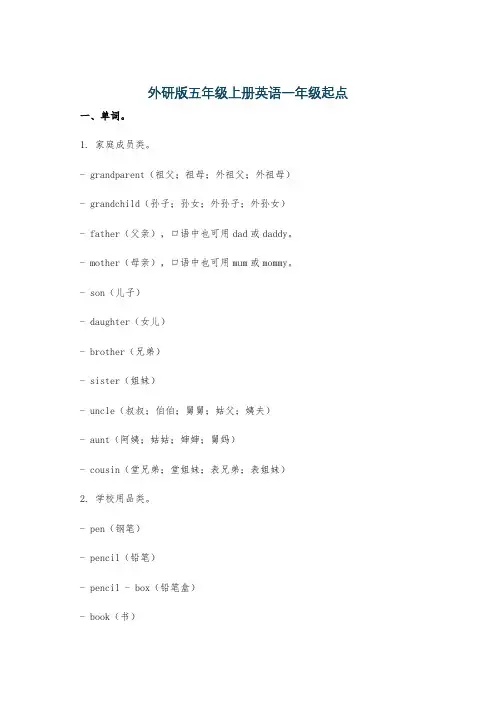
外研版五年级上册英语一年级起点一、单词。
1. 家庭成员类。
- grandparent(祖父;祖母;外祖父;外祖母)- grandchild(孙子;孙女;外孙子;外孙女)- father(父亲),口语中也可用dad或daddy。
- mother(母亲),口语中也可用mum或mommy。
- son(儿子)- daughter(女儿)- brother(兄弟)- sister(姐妹)- uncle(叔叔;伯伯;舅舅;姑父;姨夫)- aunt(阿姨;姑姑;婶婶;舅妈)- cousin(堂兄弟;堂姐妹;表兄弟;表姐妹)2. 学校用品类。
- pen(钢笔)- pencil(铅笔)- pencil - box(铅笔盒)- book(书)- schoolbag(书包)- eraser(橡皮)- ruler(尺子)3. 形容词类。
- big(大的)- small(小的)- long(长的)- short(短的;矮的)- tall(高的)- fat(胖的)- thin(瘦的)- new(新的)- old(旧的;老的)4. 动词类。
- have(有)- has(have的第三人称单数形式,有)- like(喜欢)- love(喜爱)- play(玩;打;弹)- read(读;阅读)- write(写)- draw(画)- sing(唱)- dance(跳舞)二、重点句型。
1. 描述人物关系。
- This is my father/mother/brother/sister...(这是我的父亲/母亲/兄弟/姐妹……)- He/She is my uncle/aunt/cousin...(他/她是我的叔叔/阿姨/表兄弟……)- I'm his/her son/daughter/cousin...(我是他/她的儿子/女儿/表兄弟……)2. 描述事物特征。
- My schoolbag is big/small/new/old.(我的书包大/小/新/旧。
五年级英语上册M78重点单词句型知识汇总外研版一起
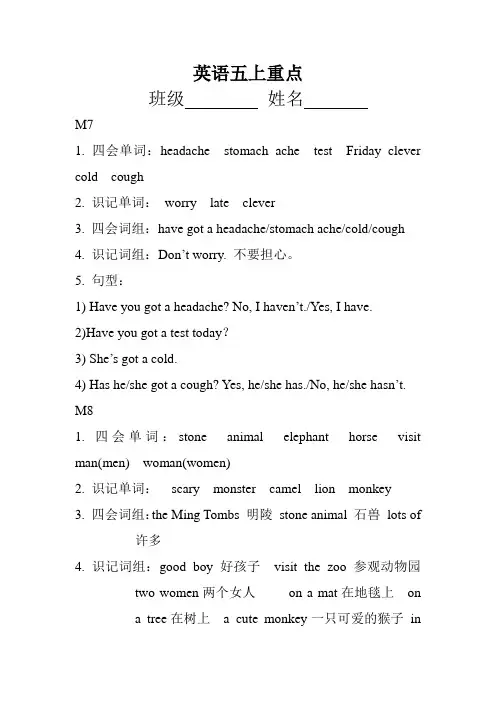
英语五上重点班级姓名M71. 四会单词:headache stomach ache test Friday clever cold cough2. 识记单词:worry late clever3. 四会词组:have got a headache/stomach ache/cold/cough4. 识记词组:Don’t worry. 不要担心。
5. 句型:1) Have you got a headache? No, I haven’t./Yes, I have.2)Have you got a test today?3) She’s got a cold.4) Has he/she got a cough? Yes, he/she has./No, he/she hasn’t. M81. 四会单词:stone animal elephant horse visit man(men) woman(women)2. 识记单词:scary monster camel lion monkey3. 四会词组:the Ming Tombs 明陵stone animal 石兽lots of许多4. 识记词组:good boy好孩子visit the zoo参观动物园two women两个女人on a mat在地毯上ona tree在树上 a cute monkey一只可爱的猴子inmy family 在我家5. 句型:1) There is a camel.2) There are stone animals.3) How many stone animals are there?4) How many people are there in your family?5) How many boys/girls/men/women? (There is one. There are two.)。
五年级上册知识点汇总(外研版一起)
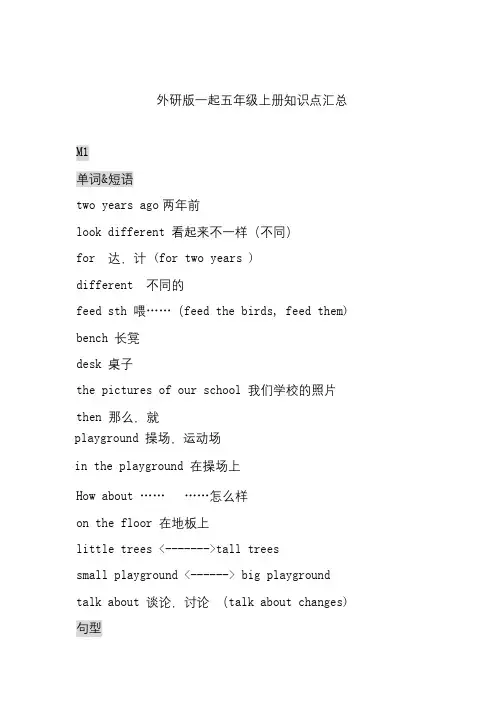
外研版一起五年级上册知识点汇总M1单词&短语two years ago两年前look different看起来不一样(不同)for达,计(for two years)different不同的feed sth喂……(feed the birds,feed them) bench长凳desk桌子the pictures of our school我们学校的照片then那么,就playground操场,运动场in the playground在操场上How about…………怎么样on the floor在地板上little trees<------->tall treessmall playground<------>big playground talk about谈论,讨论(talk about changes) 句型1.This is……vs This was……2.There be句型的一般现在时There is/are3.There be句型的过去时There was/were4.There be一般过去时否定句there was/were not如:There wasn’t a clock here before.There weren’t any benches here before.5.一般现在时的一般疑问句结构:Do/Does+主语+动词原形+……+表时间的词语+?注意:主语是第三人称单数的,把Does提前。
主语除去第一、二人称及第三人称的复数形式,其余的都属于三单例句:Does London look different now?回答:Yes,it does(主语+do/does)/No,it doesn’t.(主语+do/does+not)例句:Do you like the park now?回答:Yes,I do.(一般疑问句中的主语是第二人称的,回答要变为第一人称I或we)No,I don’t.------------------------------------------------------ -------------------------------------------------M2单词和短语heavy重的let允许,让come on快点sell卖,销售sometimes有时over there在那边put……in……把……放在……里put the bags in the carcarry运送,搬运helpful有帮助的,乐于助人的a lot of=lots of后跟可数名词复数或不可数名词goody复数:goodies好吃的东西句型:1.Let’s=Let us+动词原形让我们……吧。
外研版(一起)五年级英语上册知识汇总

外研版(一起)五年级英语上册知识汇总外研版英语(一起)五年级上册总复习知识汇总外研(一起)五年级Module 1 知识汇总一、词汇bench(长凳) playground(操场,运动场) for(达,计) different(不同的) then(那么,就)二、习惯搭配in China在中国on the floor在地板上look different看起来不同feed the birds喂鸟the pictures of.........的照片lots of许多in the classroom在教室里look at...看...... 三、重点句型 1. 描述某处有某人/某物的句型: There is + 可数名词单数/不可数名词 + 其他.There are + 可数名词复数 + 其他.eg: 1. There is a bird on thetree. 2. There are some books in the schoolbag. 更多教学资源请关注微信公众号:新标准英语2. 描述某处以前没有某物的句型:There wasn’t + 可数名词单数/不可数名词 + 其他 +before.There weren’t + 可数名词复数 + 其他 + before.eg: 1. There wasn’t a river here before. 2. There weren’t any benches in this park before.Module 2一、词汇heavy(重的) let(允许,让) sell(卖,销售) sometimes(有时)二、习惯搭配a lot of许多go to the supermarket去超市over there在那边come on快点儿put ... in ...把......放进......里三、常用表达1. Le t’s go!让我们走吧!2. Let me help you.让我帮你吧。
(完整word版)外研版一起五年级上册知识点汇总
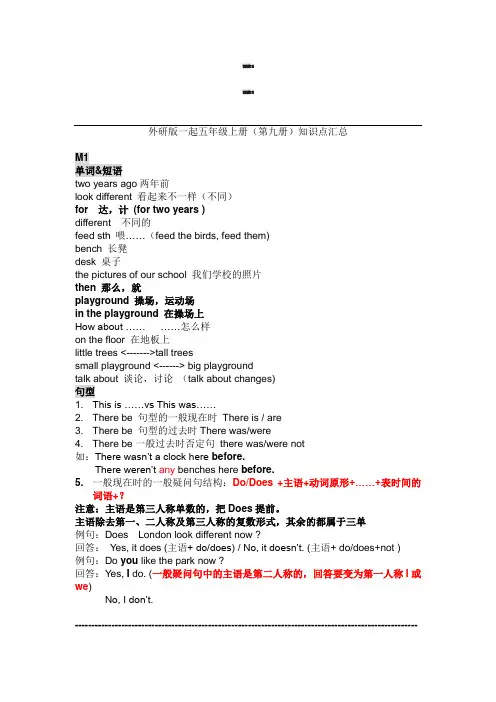
F o r p e s o n a u s e o n y s t u d y a n d r e s a r c h;n o t f r c o m me r c a u s eF o r p e s o n a u s e o n y s t u d y a n d r e s a r c h;n o t f r c o m me r c a u s e外研版一起五年级上册(第九册)知识点汇总M1单词&短语two years ago两年前look different 看起来不一样(不同)for 达,计(for two years )different 不同的feed sth 喂……(feed the birds, feed them)bench 长凳desk 桌子the pictures of our school 我们学校的照片then 那么,就playground 操场,运动场in the playground 在操场上How about …… ……怎么样on the floor 在地板上little trees <------->tall treessmall playground <------> big playgroundtalk about 谈论,讨论(talk about changes)句型1. This is ……vs This was……2. There be 句型的一般现在时There is / are3. There be 句型的过去时There was/were4. There be一般过去时否定句there was/were not如:There wasn’t a clock here before.There weren’t any benches here before.5. 一般现在时的一般疑问句结构:Do/Does +主语+动词原形+……+表时间的词语+?注意:主语是第三人称单数的,把Does提前。
外研社英语教材(一年级起点版)五年级上册知识点总结
外研社英语教材(一年级起点版)五年级上册知识点总结1. be的过去时表达be的过去时表达,Yuki - 外研社英语5年级上册(一年级起点版)There was / were 表示“过去有什么”① There is / isn't, There are / aren'tThere was / wasn't, There were / weren't②There was a bench here four years ago. (四年前这里有长凳。
)There were 20 bench es here four years ago. (四年前这里有20把长凳。
)③There wasn't a school here before. (以前,这里没有学校。
)There weren't any schools in this city before. (以前,这个城市没有任何学校。
)询问某人或某物的情况:陈述句:主语+ was / were + 形容词+ .④He was sad yesterday. (他昨天伤心了。
)一般疑问句:Was / Were + 主语+ 形容词+ ?⑤Were they naughty? (它们淘气吗?)--- Yes, they were. (是的,它们淘气。
)/ No, they weren't. (不,它们不淘气。
)(am / is - was, are - were, isn't - wasn't, aren't - weren't, bench - benches,'ch"结尾的名词变复数加"es"。
)2. 一般现在时问句:一般现在时问句,Yuki - 外研社英语5年级上册(一年级起点版)一般疑问句:Do / Does + 主语+ 动词原形...... + ?① Do you want to play basketball?(你想打篮球吗?)--- Yes, I do. (是的,我想。
外研社五年级上知识点
外研社五年级上知识点外研社五年级上学期的知识点覆盖了多个领域,包括语言知识、文化理解、思维技能和学习策略等。
以下是一些主要的知识点概览:1. 词汇学习:五年级的学生需要掌握更多的词汇,包括日常生活用语、学校用语、动植物名称、自然现象等。
词汇的积累对于提高语言表达能力至关重要。
2. 语法知识:语法是语言学习的基础。
五年级学生需要学习更多的语法规则,如时态的使用(一般现在时、一般过去时、一般将来时)、名词的复数形式、动词的第三人称单数形式等。
3. 阅读理解:通过阅读不同类型的文本,如故事、诗歌、说明文等,学生可以提高理解能力和分析能力。
同时,学习如何从文本中提取信息、理解作者意图和文本结构。
4. 写作技巧:学生将学习如何写简单的故事、描述性段落和简短的报告。
这包括如何组织思想、使用恰当的连接词以及如何进行段落划分。
5. 口语表达:通过角色扮演、小组讨论和演讲等活动,学生可以提高口语表达能力。
学习如何清晰、准确地表达自己的想法,并能够倾听和回应他人的观点。
6. 文化意识:了解不同国家的文化习俗和节日,培养学生的跨文化交际能力。
这有助于学生更好地理解语言背后的文化含义。
7. 思维技能:通过解决问题、批判性思维和创造性思维的练习,学生能够发展自己的思维能力。
这包括分析问题、评估信息和形成自己的见解。
8. 学习策略:学生将学习有效的学习策略,如如何制定学习计划、如何进行有效的复习和如何利用不同的学习资源。
9. 情感态度:鼓励学生对学习保持积极的态度,培养他们的自信心和合作精神。
10. 价值观教育:通过各种教学活动,引导学生形成正确的价值观,如尊重他人、诚实守信和公平竞争。
总结来说,外研社五年级上学期的知识点旨在全面提升学生的语言能力,同时注重培养他们的思维技能和文化理解,为他们的全面发展打下坚实的基础。
外研社五年级上册语文知识点梳理
外研社五年级上册语文知识点梳理本文档旨在对外研社五年级上册语文课程的知识点进行梳理,以帮助学生更好地研究和掌握相关内容。
一、课文知识点1. 课文标题:了不起的盖茨比- 主要内容:讲述了盖茨比的生平和成功经历,反映了努力和追求梦想的重要性。
- 生词研究:通过研究生词,扩展词汇量。
2. 课文标题:爱迪生——伟大的发明家- 主要内容:介绍了爱迪生的成就和他对世界的影响,激励学生勇往直前,追求自己的梦想。
- 句型分析:分析课文中的典型句型结构,提高学生的句子构造能力。
3. 课文标题:美丽的心灵——贝多芬- 主要内容:讲述了贝多芬的生平和他创作音乐的过程,激发学生对音乐的热爱与创作的兴趣。
- 故事分析:分析故事结构和情节发展,提高学生的阅读理解能力。
二、词语知识点1. 同义词辨析:通过研究常见的同义词,提升词语辨析和运用能力。
2. 词语搭配:研究常用的词语搭配,扩展词汇应用范围。
3. 成语研究:研究常用成语的意思和用法,提高语言表达的准确性。
三、语法知识点1. 词性辨析:研究名词、动词、形容词等词性的区分和用法。
2. 时态研究:研究一般现在时、一般过去时等基本时态的用法。
3. 句型转换:通过句型转换练,提升语法运用能力。
四、写作知识点1. 写作基础:研究基本书写规范、标点符号使用和段落结构。
2. 描述写作:研究如何清晰地描述事物和人物。
3. 议论文写作:研究如何展开观点陈述和论证。
以上为外研社五年级上册语文知识点的梳理,请学生们结合教材内容进行学习和复习,加深对语文知识的理解和掌握。
外研版一起五年级上册知识点归纳
外研版一起五年级上册知识点归纳语文知识点1. 词语解释:包括词语的词义、词性、近义词、反义词等内容。
2. 造句:根据所学词语,合理运用构成句子。
3. 写话:通过书写来表达自己的想法和感受。
4. 表达能力:培养学生正确、流畅、连贯的语言表达能力。
数学知识点1. 数的认识:认识从0到100以内的数的基本特点,如大小、顺序等。
2. 数的组成:理解以10为单位进行数的组成和拆分。
3. 加法:研究两位数相加的运算方法。
4. 减法:研究两位数相减的运算方法。
5. 数的排序:研究使用大小符号进行数字排序。
6. 数的估算:研究通过估算解决实际问题。
7. 数的读法:研究正确读写数的方法。
英语知识点1. 单词研究:研究掌握一些日常用语、简单问句和应答用语。
2. 语法研究:了解一些简单的语法规则,如动词的变化形式、名词的复数形式等。
3. 句子构造:研究根据所学词汇和语法规则进行句子构造。
4. 对话练:通过模拟对话练提高英语口语能力。
5. 听力训练:通过听力材料提高认知、听力和理解能力。
科学知识点1. 天体观察:研究认识太阳、月亮和星星,并了解它们的特点。
2. 生物世界:研究观察、认识一些常见的动植物,并了解它们的生存环境和生活性。
3. 自然现象:研究观察、了解一些常见的自然现象如天气变化、水循环等。
社会知识点1. 国家地理:研究了解自己所在的国家的基本地理情况。
2. 传统文化:了解一些中国的传统节日、俗和文化,培养对传统文化的兴趣和爱好。
3. 社交礼仪:研究一些基本的社交礼仪、待人接物的准则。
总结本文档对外研版一起五年级上册的知识点进行了简要归纳,涵盖了语文、数学、英语、科学和社会多个学科的知识点。
希望本文档能够帮助同学们更好地掌握所学知识,提高学习效果。
- 1、下载文档前请自行甄别文档内容的完整性,平台不提供额外的编辑、内容补充、找答案等附加服务。
- 2、"仅部分预览"的文档,不可在线预览部分如存在完整性等问题,可反馈申请退款(可完整预览的文档不适用该条件!)。
- 3、如文档侵犯您的权益,请联系客服反馈,我们会尽快为您处理(人工客服工作时间:9:00-18:30)。
外研版一起五年级上册(第九册)知识点汇总M1单词&短语two years ago两年前look different 看起来不一样(不同)for 达,计(for two years )different 不同的feed sth 喂……(feed the birds, feed them)bench 长凳desk 桌子the pictures of our school 我们学校的照片then 那么,就playground 操场,运动场in the playground 在操场上How about …… ……怎么样on the floor 在地板上little trees <------->tall treessmall playground <------> big playgroundtalk about 谈论,讨论(talk about changes)句型1.This is ……vs This was……2.There be 句型的一般现在时There is / are3.There be 句型的过去时There was/were4.There be一般过去时否定句there was/were notbefore.如:There wasn’t a clock hereany benches here before.There weren’t5.一般现在时的一般疑问句结构:Do/Does +主语+动词原形+……+表时间的词语+?注意:主语是第三人称单数的,把Does提前。
主语除去第一、二人称及第三人称的复数形式,其余的都属于三单例句:Does London look different now ?主语+ do/does+not )回答:Yes, it does (主语+ do/does) / No, it doesn’t. (例句:Do you like the park now ?回答:Yes, I do. (一般疑问句中的主语是第二人称的,回答要变为第一人称I或we) No, I don’t.-------------------------------------------------------------------------------------------------------M2单词和短语heavy 重的let 允许,让come on 快点put ……in ……把……放在……里put the bags in the carcarry 运送,搬运helpful 有帮助的,乐于助人的a lot of = lots of 后跟可数名词复数或不可数名词goody 复数:goodies 好吃的东西句型:1. Let’s=Le t us + 动词原形让我们……吧。
例句:Let’s go to the supermarket.Let’s go .2. What +a/an +形容词+可数名词单数+ !感叹句,表达喜、怒、哀、乐以及惊奇、惊讶等强烈感情的句子。
例句:What a big supermarket !What + 形容词+ 可数名词复数+ !例句:What good children !或者What + 形容词+ 不可数名词+ !。
例句:What fresh food !连接多个名词(可数或不可数),通常用在最后一个名词前。
3.连词“and” 例句:They sell food, clothes, toys and CDs.4. This is my favourite + 名词-------------------------------------------------------------------------------------------------------M3单词&短语Halloween 万圣节前夕at Halloween 在万圣节Happy Halloween 万圣节快乐!trick or treat 不请吃就捣蛋give 给,送festival 节日an autumn / a spring / a winter festival 一个秋天的/春天的/冬天的节日scary 吓人的,可怕的scary clothesmask 面具neighbour 邻居night 夜晚,夜间Easter 复活节look at看……on the hat 在帽子上Easter hats 复活节帽子chick 小鸡chocolate 巧克力chocolate eggs 巧克力蛋Easter eggs 复活节蛋yammy food s美味的食物。
the Spring Festival 春节(用介词at )the Mid-Autumn Festival 仲秋节(用介词at )母亲节/ 父亲节/ 儿童节(用介词on)Mother’s Day / Father’s Day / Children’ s Dayposter 海报make a poster 做海报句型:1.You look + 形容词你看起来……例句:You look scary.She looks nice.2.What + do / does + 主语+ 动词原形+……+?一般现在时的特殊疑问句,What用来提问就做什么。
例句:What do children do at Halloween?What do their neighbours do ?What does your father do ?3.How many + 可数名词复数+ are + there ? 一般现在时的特殊疑问句,How many用来提问数量多少。
例句:How many eggs are there ?回答用There be 句型. There be句型中be动词的单复数形式由最挨近的一项名词的单复数决定.n.例句:There is only one. / There’re te4.Do you know why 知道为什么吗?M4单词&短语stories (story 的复数形式)故事invitation 请帖an invitation to my birthday party 生日聚会邀请函an invitation to + 表地点的名词after lunch 午餐后before lunch 午餐前see a film 看电影tidy up收拾,整理at the weekend 在周末(用在一般现在时、一般将来时)come to + 地方来……(如:come to my party)November 十一月from (表示时间)从……起to 直到reply回答,回复play games with …… 和……做游戏句型:表将来要发生的事1.be going to ……句子结构:主语+ be (am, is , are ) going to + 动词原形。
例句:We are going to tell stories.I’m going to be eleven.2. 现在进行时句子结构:主语+ be动词(am , is , are )+ 动词的ing 形式例句:What are you going to do ?疑问句中的主语是第二人称的,回答要变为第一人称I或we回答:We are going to ……I’m going to ……4.help sb (to) do sth 帮助某人做某事例句:you are going to help me tidy up.5.特殊疑问句的主语是第一人称,回答时既可能是第一人称,也可能是第二人称例句:What are w e going to do ?回答:We are going to have lunch together . 如果回复人属于事件的参与者时,回答要用we.例句:What are w e going to do in the concert.回答:You are going to play the erhu . 如果回复人不属于事件的参与者时,回答时要将主语变为You.-------------------------------------------------------------------------------------------------------M5单词&短语mine我的(名词性物主代词)whose 谁的yours 你的,你们的hers 她的both 两……(都),两个……(都)run home 往家跑wet湿的没关系That’s OK.take away移走,拿走worker 工人still还,仍然句型1.Whose + 名词+ be 动词+ 代词+ ?whose谁的,用来提问所属关系例句:Whose eraser is it ?Whose flowers are they ?回答用名词性物主代词。
相当于名词,后面不再加名词。
要么出现在句首,要么出现在句尾。
(=my eraser ).例句:It’s mineIt’s yours(=your eraser).3.both表复数含义,be动词要用复数形式。
例句: Both your T-shirts are wet.both your T-shirts = both of your T-shirts-------------------------------------------------------------------------------------------------------M6单词&短语well 好,熟练地high 高高地true 真实的match 比赛after the match 比赛后got (get的过去式)得到eighty 八十point 分数get + 基数词+ point(s) 得到多少分fan 狂热爱好者,迷first fan 第一球迷seventy 七十sixty 六十the other team 另一队句型1.一般现在时的一般疑问句句子结构:Do / Does + 主语+ 动词原形+ 其他+ ?例句:Do you want to play basketball ?回答:Yes, I do .No, I don’t .注意:疑问句中是第二人称的,回答时要变为第一人称。
2.情态动词can 的用法情态动词是一种本身有一定的词义,表示说话人的情绪、态度或语气的动词,但不能单独作谓语,只能和其他动词原形构成谓语。
3. 含情态动词的陈述句结构:主语+ can + 动词原形。
